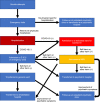Remorse-related suicide attempts among young mothers after COVID-19 infection
- PMID: 38868140
- PMCID: PMC11114347
- DOI: 10.1002/pcn5.116
Remorse-related suicide attempts among young mothers after COVID-19 infection
Abstract
Background: In Japan, there is a tendency to view COVID-19 infection as one's own responsibility, which may result in more feelings of guilt than in other countries. During the COVID-19 pandemic, the curfew imposed by COVID-19 restricted social behavior and increased anxiety and loneliness, which may have increased the risk of suicide among young women, especially mothers who were highly stressed regarding COVID-19 infection in their children.
Case presentation: This is a case report of two Japanese mothers who developed feelings of guilt following infection with COVID-19, leading to suicide attempts. They feared stigma or denial due to the infection, which they were unable to explain to others, leading to a heightened sense of self-blame and suicide attempts. In addition, Japanese women have a heavy burden of housework, despite their dual roles at home and at work; the pandemic's behavioral restrictions led to increased time at home and stress. These women were also more affected by the economic crisis in the early stages of the pandemic than men. Relatedly, neuropsychiatric symptoms that persisted after recovering from COVID-19, such as depression, anxiety, fatigue, and pain, namely postacute COVID-19 syndrome or long COVID, may have precipitated the suicidal ideation in these cases. Moreover, the complication of bipolar disorder by COVID-19 could have led to suicide attempts caused by infection-related neuropsychiatric symptoms and the exacerbation of the bipolar disorder by restrictions imposed during the pandemic.
Conclusion: Suicide prevention measures need to be taken more seriously among mothers during or after the COVID-19 pandemic.
Keywords: COVID‐19; Japan; mother; remorse; suicide; young women.
© 2023 The Authors. Psychiatry and Clinical Neurosciences Reports published by John Wiley & Sons Australia, Ltd on behalf of Japanese Society of Psychiatry and Neurology.
Conflict of interest statement
The authors declare no conflict of interest.
Figures
Similar articles
-
Suicidal ideation and suicide attempts among students aged 12 to 24 after the lifting of COVID-19 restrictions in China: prevalence and associated factors.Front Psychiatry. 2024 Jun 18;15:1383992. doi: 10.3389/fpsyt.2024.1383992. eCollection 2024. Front Psychiatry. 2024. PMID: 38962062 Free PMC article.
-
The impact of the COVID-19 pandemic on children and young people.Psychiatriki. 2023 Dec 29;34(4):265-268. doi: 10.22365/jpsych.2023.024. Epub 2023 Nov 14. Psychiatriki. 2023. PMID: 37982248 English, Greek, Modern.
-
An elderly patient with depression and a suicide attempt during the COVID-19 pandemic: a case report.Front Psychiatry. 2023 Sep 28;14:1151482. doi: 10.3389/fpsyt.2023.1151482. eCollection 2023. Front Psychiatry. 2023. PMID: 37840789 Free PMC article.
-
Prevention of suicide and attempted suicide in Denmark. Epidemiological studies of suicide and intervention studies in selected risk groups.Dan Med Bull. 2007 Nov;54(4):306-69. Dan Med Bull. 2007. PMID: 18208680 Review.
-
[Suicidal behavior in light of COVID-19 outbreak: Clinical challenges and treatment perspectives].Encephale. 2020 Jun;46(3S):S66-S72. doi: 10.1016/j.encep.2020.05.001. Epub 2020 May 8. Encephale. 2020. PMID: 32471707 Free PMC article. Review. French.
References
Publication types
LinkOut - more resources
Full Text Sources
Research Materials


